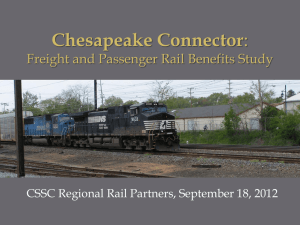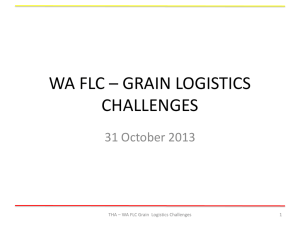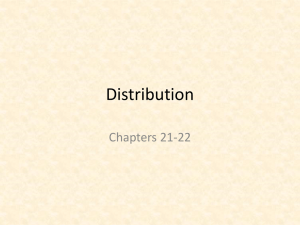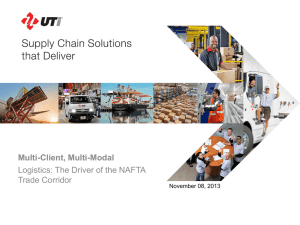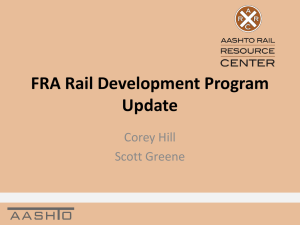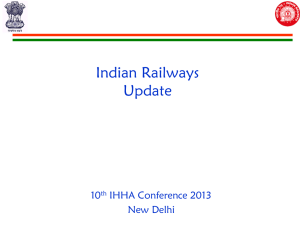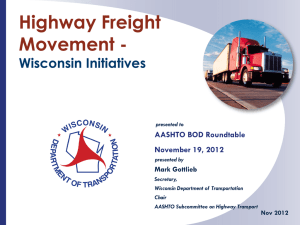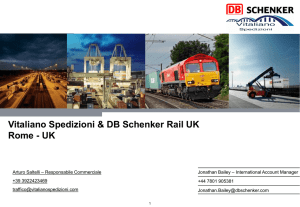May 2014 - Freight and Logistics Council of Western Australia
advertisement
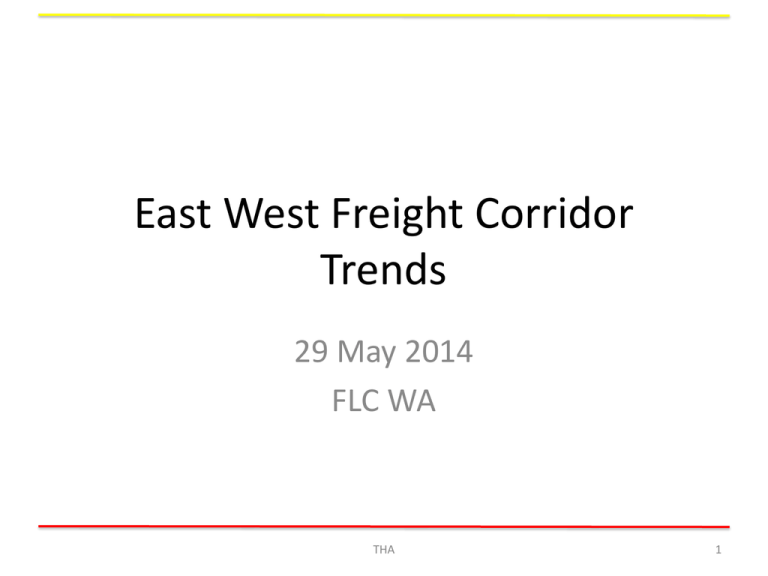
East West Freight Corridor Trends 29 May 2014 FLC WA THA 1 Study aim To test the thesis that east-west Australian freight volumes and growth rates are being reduced by an increase in north-south freight into WA THA FLC WA 2 Study Approach • Review of available data on east-west corridor freight • Examination of observed new supply chain behaviour in retail logistics sector • Suggestions for improved freight analysis THA FLC WA 3 Available data • National data sources including BITRE, ABS • Rail data from network operator • Sea freight data from BITRE, port authorities THA FLC WA 4 BITRE 2010 Interstate Freight in Australia • estimated freight on interstate corridors 1972-2007 • disaggregated into separate modes • forecasts freight to 2030 THA FLC WA 5 East West Freight Task tonne kilometres THA FLC WA 6 East West Freight Task estimated and forecast growth rates THA FLC WA 7 East West Rail Freight Task • Brookfield can supply high level rail data • Gross tonne kilometres and train counts • Otherwise data confidential to customers • No data available on the nature of the freight THA FLC WA 8 East West Rail Freight Task 15% Annual Growth Rate 10% 5% 0% 2004 2005 2006 2007 2008 2009 2010 2011 2012 2013 -5% -10% -15% THA FLC WA 9 Sea Freight Data • BITRE annual summary of Australian Sea Freight and port activity • Aggregated data, difficult to separate bulk from general freight • Container freight limited to containers carried under coastal voyage permits THA FLC WA 10 Available data limitations • Some national time series data (ABS, BITRE etc) available but highly aggregated and questionable • Often rely on industry surveys • Forecasts usually based on statistical techniques rather than underlying analysis of freight generating activity • Lack of good modal data at industry segment level (retail, manufacturing, food etc) • Understanding container freight made complicated by large empty container volumes THA FLC WA 11 East-west freight understanding • East-west volumes have grown strongly since 1970s • Rail dominates land transport, but coastal sea freight significant • Volatile bulk minerals freight movements (especially by sea) can disguise trends in general freight (household and manufacturing) THA FLC WA 12 Container Freight into Fremantle • Trade data accumulated into broad industrial groupings for last 10 years • Full International imports 272,000 TEU, growing 9% per year to 2013 • Full Coastal ‘imports’ 56,000 growing at 3.5% • 2014 volumes estimated from ytd April THA FLC WA 13 Import Freight by country of origin (TEU) THA FLC WA 14 Chinese imports growing • High growth, especially in household goods THA FLC WA 15 Australian imports static •Trade fairly steady in recent years over a variety of commodities THA FLC WA 16 East West Freight - best available estimates Best estimates suggest modal split: 7% sea, 62% rail, 31% road 10,000 Interstate Tonnes (000's) 9,000 8,000 7,000 6,000 Sea 5,000 Rail 4,000 Road 3,000 2,000 1,000 2007 2008 2009 2010 2011 2012 2013 Data woefully inadequate to identify trends in general freight THA FLC WA 17 Retail Supply Chain Trends • Two sectors: – Supermarkets and grocery – Consumer goods • Supermarket sector highly concentrated, Coles and Woolworths controlling 73% sales (est 12k TEU pa) • Consumer sector relies more heavily on imports and is much more disaggregated (est 60k TEU pa) Source THA,IBIS World G4111 THA FLC WA 18 Retail Study 1 – Kmart (Sydney) • Example of increased dependence on imports affecting supply chain • 50,000sqm warehouse opened Eastern Creek 2003 • Receiving point for all NSW supplies • Handles 400 TEU per week • Large container storage space – long supply chain • Low value high volume product • WA supplied direct from overseas to local DC • No significant interstate movements THA FLC WA 19 Retail Study 2 - Target • National Melbourne centred distribution model to 2013 • Replaced with regional DC model, increased imports, potential for streamlining • Malaysian hub packs store-specific containers from various Asian sources • Also imports from China and Bangladesh direct into Fremantle • Reduction in east-west freight movement • CTI Logistics facility growing from 2000sqm to 30,000sqm in 5 years THA FLC WA 20 Target chain realignment Target’s Supply Chain – 2013 Target’s Supply Chain – 2014 THA FLC WA 21 Retail study 3 – Supermarket Supply Chains • Woolworths and Coles (73%) have large DC’s near airport • More local product than consumer goods • Private labels imported and increasing (28%) • Aldi (10%) opening DC at Jandakot • Higher level of private label (imported) product • IGA, part of Metcash group (hardware, liquor,automotive) • IGA have DCs but large proportion product delivered direct to store by supplier THA FLC WA 22 National Retail chain models • Major retailers migrating to new large DCs in logistics precincts in most cities, consolidating smaller warehouses • Greater reliance on imports, especially in consumer goods • National distribution models (based in Sydney and Melbourne) being replace by regional distribution by some major retailers THA FLC WA 23 Supply Chain Findings • Significant reorientation around Asian supply networks for some if not all retailers • Scale of Perth warrants move away from east coast DC model • Potential significant impact on land use in Forrestfield/ Hazlemere • Volumes small in overall east-west context but growing THA FLC WA 24 Freight data and analysis improvements • Seek systematic disaggregated data from Brookfield Rail and rail operators • Engage with major rail freight forwarders to understand their customer bases and design a qualitative long term survey re rail usage • Use Fremantle Ports database to design a regular reporting protocol on containerised commodities • Seek engagement with local retail sector to understand import v domestic supplier reliance THA FLC WA 25
